Dell 3100, E310 User Manual
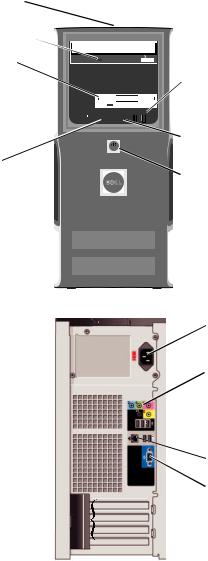
Dell™ Dimension™ 3100/E310
Owner’s Manual
Service Tag
CD or DVD activity light
FlexBay for optional floppy drive or Media Card Reader
floppy drive or Media Card Reader
headphone connector
 1
1 2 3 4
2 3 4
diagnostic lights 
cover latch release 
card slots for PCI (2),
PCI Express x1 (1)
 CD or DVD eject button
CD or DVD eject button
 USB 2.0 connectors (2)
USB 2.0 connectors (2)
 hard drive activity light
hard drive activity light
 power button
power button
 power connector
power connector
 sound-card connectors
sound-card connectors
 USB 2.0 connectors (4)
USB 2.0 connectors (4)
 network adapter
network adapter
 VGA video connector (integrated)
VGA video connector (integrated)
Model DCSM
w w w . d e l l . c o m | s u p p o r t . d e l l . c o m

Notes, Notices, and Cautions
NOTE: A NOTE indicates important information that helps you make better use of your computer.
NOTICE: A NOTICE indicates either potential damage to hardware or loss of data and tells you how to avoid the problem.
 CAUTION: A CAUTION indicates a potential for property damage, personal injury, or death.
CAUTION: A CAUTION indicates a potential for property damage, personal injury, or death.
If you purchased a Dell™ n Series computer, any references in this document to Microsoft® Windows® operating systems are not applicable.
____________________
Information in this document is subject to change without notice. © 2004–2006 Dell Inc. All rights reserved.
Reproduction in any manner whatsoever without the written permission of Dell Inc. is strictly forbidden.
Trademarks used in this text: Dell, the DELL logo, Inspiron, Dell Precision, Dimension, OptiPlex, Latitude, PowerEdge, PowerVault, PowerApp, DellNet, and PowerConnect are trademarks of Dell Inc.; Intel and Pentium are registered trademarks of Intel Corporation; Microsoft, Windows, and Outlook are registered trademarks of Microsoft Corporation.
Other trademarks and trade names may be used in this document to refer to either the entities claiming the marks and names or their products. Dell Inc. disclaims any proprietary interest in trademarks and trade names other than its own.
Model DCSM
September 2006 |
P/N DD137 |
Rev. A03 |

Contents
Finding Information . . . . . . . . . . . . . . . . . . . . . . . . . . . . . . . . 9
1 Setting Up and Using Your Computer
Setting Up a Printer . . . . . . . . . . . . . . . . . . . . . . . . . . . . . . . |
13 |
Printer Cable . . . . . . . . . . . . . . . . . . . . . . . . . . . . . . . . |
13 |
Connecting a USB Printer. . . . . . . . . . . . . . . . . . . . . . . . . . |
13 |
Connecting to the Internet . . . . . . . . . . . . . . . . . . . . . . . . . . . . |
14 |
Setting Up Your Internet Connection . . . . . . . . . . . . . . . . . . . . |
15 |
Playing CDs and DVDs . . . . . . . . . . . . . . . . . . . . . . . . . . . . . . |
16 |
Adjusting the Volume . . . . . . . . . . . . . . . . . . . . . . . . . . . . |
17 |
Adjusting the Picture . . . . . . . . . . . . . . . . . . . . . . . . . . . . |
18 |
Copying CDs and DVDs. . . . . . . . . . . . . . . . . . . . . . . . . . . . . . |
18 |
How to Copy a CD or DVD. . . . . . . . . . . . . . . . . . . . . . . . . . |
18 |
Using Blank CDs and DVDs . . . . . . . . . . . . . . . . . . . . . . . . . |
19 |
Helpful Tips . . . . . . . . . . . . . . . . . . . . . . . . . . . . . . . . . |
20 |
Using a Media Card Reader (Optional) . . . . . . . . . . . . . . . . . . . . . |
20 |
Setting Up a Home and Office Network . . . . . . . . . . . . . . . . . . . . . |
21 |
Connecting to a Network Adapter . . . . . . . . . . . . . . . . . . . . . |
21 |
Network Setup Wizard . . . . . . . . . . . . . . . . . . . . . . . . . . . |
22 |
Power Management . . . . . . . . . . . . . . . . . . . . . . . . . . . . . . . |
22 |
Standby Mode . . . . . . . . . . . . . . . . . . . . . . . . . . . . . . . |
23 |
Hibernate Mode. . . . . . . . . . . . . . . . . . . . . . . . . . . . . . . |
23 |
Power Options Properties . . . . . . . . . . . . . . . . . . . . . . . . . |
23 |
About RAID Configurations . . . . . . . . . . . . . . . . . . . . . . . . . . . |
25 |
Using RAID with Hard Drive Passwords . . . . . . . . . . . . . . . . . . |
25 |
RAID Level 1. . . . . . . . . . . . . . . . . . . . . . . . . . . . . . . . . |
25 |
Configuring Your Computer for RAID . . . . . . . . . . . . . . . . . . . . |
26 |
Setting Your Computer to RAID-Enabled Mode . . . . . . . . . . . . . . |
26 |
Configuring Your Computer for RAID Using the Intel® |
|
RAID Option ROM Utility . . . . . . . . . . . . . . . . . . . . . . . . . . |
27 |
Contents 3

Configuring Your Computer for RAID Using the Intel Matrix Storage Manager
Hyper-Threading . . . . . . . . . . . . . . . . . . . . . . . . .
. . . . . . . . 28
. . . . . . . . 30
2 Solving Problems
Troubleshooting Tips . . . . . . . . . . . . . . . . . . . . . . . . . . . . . . . |
31 |
Battery Problems. . . . . . . . . . . . . . . . . . . . . . . . . . . . . . . . . |
31 |
Drive Problems . . . . . . . . . . . . . . . . . . . . . . . . . . . . . . . . . . |
31 |
CD and DVD drive problems . . . . . . . . . . . . . . . . . . . . . . . . |
32 |
Hard drive problems . . . . . . . . . . . . . . . . . . . . . . . . . . . . |
33 |
E-Mail, Modem, and Internet Problems . . . . . . . . . . . . . . . . . . . . . |
33 |
Error Messages . . . . . . . . . . . . . . . . . . . . . . . . . . . . . . . . . |
34 |
Media Card Reader Problems . . . . . . . . . . . . . . . . . . . . . . . . . . |
35 |
Keyboard Problems . . . . . . . . . . . . . . . . . . . . . . . . . . . . . . . |
36 |
Lockups and Software Problems . . . . . . . . . . . . . . . . . . . . . . . . |
36 |
The computer does not start up . . . . . . . . . . . . . . . . . . . . . . |
36 |
The computer stops responding . . . . . . . . . . . . . . . . . . . . . . |
36 |
A program stops responding . . . . . . . . . . . . . . . . . . . . . . . . |
37 |
A program crashes repeatedly . . . . . . . . . . . . . . . . . . . . . . . |
37 |
A program is designed for an earlier Windows operating system . . . . . |
37 |
A solid blue screen appears . . . . . . . . . . . . . . . . . . . . . . . . |
37 |
Other software problems . . . . . . . . . . . . . . . . . . . . . . . . . . |
38 |
Memory Problems . . . . . . . . . . . . . . . . . . . . . . . . . . . . . . . . |
38 |
Mouse Problems . . . . . . . . . . . . . . . . . . . . . . . . . . . . . . . . . |
39 |
Network Problems . . . . . . . . . . . . . . . . . . . . . . . . . . . . . . . . |
40 |
Power Problems . . . . . . . . . . . . . . . . . . . . . . . . . . . . . . . . . |
40 |
Printer Problems . . . . . . . . . . . . . . . . . . . . . . . . . . . . . . . . . |
41 |
Scanner Problems . . . . . . . . . . . . . . . . . . . . . . . . . . . . . . . . |
42 |
Sound and Speaker Problems . . . . . . . . . . . . . . . . . . . . . . . . . . |
43 |
No sound from speakers . . . . . . . . . . . . . . . . . . . . . . . . . . |
43 |
No sound from headphones . . . . . . . . . . . . . . . . . . . . . . . . |
44 |
4 Contents

Video and Monitor Problems . . . . . . . . . . . . . . . . . . . . . . . . . . |
44 |
If the screen is blank . . . . . . . . . . . . . . . . . . . . . . . . . . . . |
44 |
If the screen is difficult to read . . . . . . . . . . . . . . . . . . . . . . . |
45 |
3 Advanced Troubleshooting
Diagnostic Lights. . . . . . . . . . . . . . . . . . . . . . . . . . . . . . . . . |
47 |
Dell Diagnostics . . . . . . . . . . . . . . . . . . . . . . . . . . . . . . . . . |
50 |
Dell Diagnostics Main Menu . . . . . . . . . . . . . . . . . . . . . . . . |
50 |
Drivers . . . . . . . . . . . . . . . . . . . . . . . . . . . . . . . . . . . . . . |
51 |
What Is a Driver? . . . . . . . . . . . . . . . . . . . . . . . . . . . . . . |
51 |
Identifying Drivers . . . . . . . . . . . . . . . . . . . . . . . . . . . . . |
52 |
Reinstalling Drivers . . . . . . . . . . . . . . . . . . . . . . . . . . . . . |
52 |
Resolving Software and Hardware Incompatibilities . . . . . . . . . . . . . |
53 |
Restoring Your Operating System . . . . . . . . . . . . . . . . . . . . . . . . |
53 |
Using Microsoft® Windows® XP System Restore . . . . . . . . . . . . . |
54 |
Using Dell™ PC Restore by Symantec . . . . . . . . . . . . . . . . . . . |
55 |
Removing Dell PC Restore . . . . . . . . . . . . . . . . . . . . . . . . . |
56 |
4 Removing and Installing Parts
Before You Begin. . . . . . . . . . . . . . . . . . . . . . . . . . . . . . . . . |
57 |
Recommended Tools . . . . . . . . . . . . . . . . . . . . . . . . . . . . |
57 |
Turning Off Your Computer . . . . . . . . . . . . . . . . . . . . . . . . . |
57 |
Before Working Inside Your Computer . . . . . . . . . . . . . . . . . . . |
58 |
Front View of the Computer . . . . . . . . . . . . . . . . . . . . . . . . . . . |
59 |
Back View of the Computer . . . . . . . . . . . . . . . . . . . . . . . . . . . |
61 |
Removing the Computer Cover. . . . . . . . . . . . . . . . . . . . . . . . . . |
62 |
Inside View of Your Computer . . . . . . . . . . . . . . . . . . . . . . . . . . |
64 |
System Board Components. . . . . . . . . . . . . . . . . . . . . . . . . . . . |
65 |
Memory. . . . . . . . . . . . . . . . . . . . . . . . . . . . . . . . . . . . . . |
65 |
DDR2 Memory Overview . . . . . . . . . . . . . . . . . . . . . . . . . . |
66 |
Installing Memory. . . . . . . . . . . . . . . . . . . . . . . . . . . . . . |
67 |
Removing Memory . . . . . . . . . . . . . . . . . . . . . . . . . . . . . |
68 |
Contents 5

Cards . . . . . . . . . . . . . . . . . . . . . . . . . . . . . . . . . . . . . . . |
69 |
Drive Panels . . . . . . . . . . . . . . . . . . . . . . . . . . . . . . . . . . . |
73 |
Removing the Drive Panel . . . . . . . . . . . . . . . . . . . . . . . . . |
74 |
Removing the Drive-Panel Insert . . . . . . . . . . . . . . . . . . . . . . |
75 |
Replacing the Drive-Panel Insert . . . . . . . . . . . . . . . . . . . . . . |
75 |
Replacing the Drive Panel . . . . . . . . . . . . . . . . . . . . . . . . . |
76 |
Drives. . . . . . . . . . . . . . . . . . . . . . . . . . . . . . . . . . . . . . . |
76 |
IDE Drive Addressing . . . . . . . . . . . . . . . . . . . . . . . . . . . . |
77 |
Connecting Drive Cables . . . . . . . . . . . . . . . . . . . . . . . . . . |
77 |
Drive Interface Connectors . . . . . . . . . . . . . . . . . . . . . . . . . |
78 |
Power Cable Connector . . . . . . . . . . . . . . . . . . . . . . . . . . |
78 |
Connecting and Disconnecting Drive Cables. . . . . . . . . . . . . . . . |
79 |
Hard Drive . . . . . . . . . . . . . . . . . . . . . . . . . . . . . . . . . . . . |
79 |
Removing a Hard Drive . . . . . . . . . . . . . . . . . . . . . . . . . . . |
80 |
Installing a Hard Drive . . . . . . . . . . . . . . . . . . . . . . . . . . . |
81 |
Adding a Second Hard Drive (optional). . . . . . . . . . . . . . . . . . . |
82 |
Floppy Drive . . . . . . . . . . . . . . . . . . . . . . . . . . . . . . . . . . . |
83 |
Removing a Floppy Drive . . . . . . . . . . . . . . . . . . . . . . . . . . |
83 |
Installing a Floppy Drive . . . . . . . . . . . . . . . . . . . . . . . . . . |
85 |
Media Card Reader . . . . . . . . . . . . . . . . . . . . . . . . . . . . . . . |
87 |
Removing a Media Card Reader . . . . . . . . . . . . . . . . . . . . . . |
87 |
Installing a Media Card Reader. . . . . . . . . . . . . . . . . . . . . . . |
89 |
CD/DVD Drive. . . . . . . . . . . . . . . . . . . . . . . . . . . . . . . . . . . |
90 |
Removing a CD/DVD Drive . . . . . . . . . . . . . . . . . . . . . . . . . |
91 |
Installing a CD/DVD Drive. . . . . . . . . . . . . . . . . . . . . . . . . . |
92 |
Battery . . . . . . . . . . . . . . . . . . . . . . . . . . . . . . . . . . . . . . |
95 |
Replacing the Battery. . . . . . . . . . . . . . . . . . . . . . . . . . . . |
95 |
Replacing the Computer Cover . . . . . . . . . . . . . . . . . . . . . . . . . |
96 |
5 Appendix
Specifications . . . . . . . . . . . . . . . . . . . . . . . . . . . . . . . . . . |
99 |
System Setup . . . . . . . . . . . . . . . . . . . . . . . . . . . . . . . . . . |
103 |
Overview . . . . . . . . . . . . . . . . . . . . . . . . . . . . . . . . . |
103 |
Entering System Setup . . . . . . . . . . . . . . . . . . . . . . . . . . |
103 |
6 Contents

System Setup Options. . . . . . . . . . . . . . . . . . . . . . . . . . . |
104 |
Boot Sequence . . . . . . . . . . . . . . . . . . . . . . . . . . . . . . |
107 |
Clearing Forgotten Passwords. . . . . . . . . . . . . . . . . . . . . . . . . |
109 |
Clearing CMOS Settings . . . . . . . . . . . . . . . . . . . . . . . . . . . . |
110 |
Cleaning Your Computer . . . . . . . . . . . . . . . . . . . . . . . . . . . . |
110 |
Computer, Keyboard, and Monitor . . . . . . . . . . . . . . . . . . . . |
110 |
Mouse. . . . . . . . . . . . . . . . . . . . . . . . . . . . . . . . . . . |
111 |
Floppy Drive . . . . . . . . . . . . . . . . . . . . . . . . . . . . . . . . |
111 |
CDs and DVDs. . . . . . . . . . . . . . . . . . . . . . . . . . . . . . . |
111 |
Dell Technical Support Policy (U.S. Only) . . . . . . . . . . . . . . . . . . . |
112 |
Definition of "Dell-Installed" Software and Peripherals . . . . . . . . . |
112 |
Definition of "Third-Party" Software and Peripherals. . . . . . . . . . . |
112 |
FCC Notices (U.S. Only) . . . . . . . . . . . . . . . . . . . . . . . . . . . . |
112 |
Class A . . . . . . . . . . . . . . . . . . . . . . . . . . . . . . . . . . |
113 |
Class B . . . . . . . . . . . . . . . . . . . . . . . . . . . . . . . . . . |
113 |
FCC Identification Information . . . . . . . . . . . . . . . . . . . . . . |
114 |
Contacting Dell. . . . . . . . . . . . . . . . . . . . . . . . . . . . . . . . . |
114 |
Index . . . . . . . . . . . . . . . . . . . . . . . . . . . . . . . . . . . . . . . . |
133 |
Contents 7

8 Contents
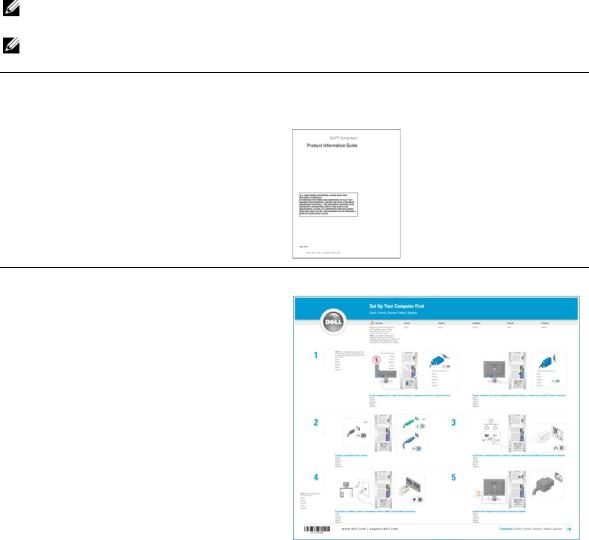
Finding Information
NOTE: Some features or media may be optional and may not ship with your computer. Some features or media may not be available in certain countries.
NOTE: Additional information may ship with your computer.
What Are You Looking For? |
Find It Here |
|
|
• Warranty information |
Dell™ Product Information Guide |
•Terms and Conditions (U.S. only)
•Safety instructions
•Regulatory information
•Ergonomics information
•End User License Agreement
• How to set up my computer |
Setup Diagram |
Finding Information |
|
9 |
|

What Are You Looking For? |
Find It Here |
|
|
• Service Tag and Express Service Code |
Service Tag and Microsoft® Windows® License |
• Microsoft Windows License Label |
These labels are located on your computer. |
|
• Use the Service Tag to |
|
identify your computer |
|
when you use |
|
support.dell.com or |
|
contact technical |
|
support. |
|
• Enter the Express |
|
Service Code to direct |
|
your call when |
|
contacting technical |
|
support. |
•Solutions — Troubleshooting hints and tips, articles from technicians, and online courses, frequently asked questions
•Community — Online discussion with other Dell customers
•Upgrades — Upgrade information for components, such as memory, the hard drive, and the operating system
•Customer Care — Contact information, service call and order status, warranty, and repair information
•Service and support — Service call status and support history, service contract, online discussions with technical support
•Reference — Computer documentation, details on my computer configuration, product specifications, and white papers
•Downloads — Certified rivers, patches, and software updates
•Desktop System Software (DSS)— If you reinstall the operating system for your computer, you should also reinstall the DSS utility. DSS provides critical updates
for your operating system and support for Dell™ 3.5-inch USB floppy drives, Intel® Pentium® M processors, optical drives, and USB devices. DSS is necessary for correct operation of your Dell computer. The software automatically detects your computer and operating system and installs the updates appropriate for your configuration.
Dell Support Website — support.dell.com
NOTE: Select your region to view the appropriate support site.
NOTE: Corporate, government, and education customers can also use the customized Dell Premier Support website at premier.support. dell.com.
To download Desktop System Software:
1 Go to support.dell.com and click Downloads.
2 Enter your Service Tag or product model.
3 In the Download Category drop-down menu, click All. 4 Select the operating system and operating system
language for your computer, and click Submit.
5 Under Select a Device, scroll to System and Configuration Utilities, and click Dell Desktop System Software.
10 Finding Information

What Are You Looking For? |
Find It Here |
|
|
|
|
• How to use Windows XP |
Windows Help and Support Center |
|
• How to work with programs and files |
1 |
Click the Start button and click Help and Support. |
• How to personalize my desktop |
2 |
Type a word or phrase that describes your problem and |
|
|
click the arrow icon. |
|
3 |
Click the topic that describes your problem. |
|
4 |
Follow the instructions on the screen. |
|
|
|
Finding Information |
|
11 |
|

12 Finding Information

Setting Up and Using Your Computer
Setting Up a Printer
NOTICE: Complete the operating system setup before you connect a printer to the computer.
See the documentation that came with the printer for setup information, including how to:
•Obtain and install updated drivers
•Connect the printer to the computer
•Load paper and install the toner or ink cartridge
•Contact the printer manufacturer for technical assistance
Printer Cable
Your printer connects to your computer with a USB cable. Your printer may not come with a printer cable, so if you purchase a cable separately, ensure that it is compatible with your printer. If you purchased a printer cable at the same time you purchased your computer, the cable may arrive in the computer box.
Connecting a USB Printer
NOTE: You can connect USB devices while the computer is turned on.
1Complete the operating system setup, if you have not already done so.
2Install the printer driver, if necessary. See the documentation that came with your printer.
3Attach the USB printer cable to the USB connectors on the computer and the printer. The USB connectors only fit into the ports when correctly oriented.
Setting Up and Using Your Computer |
|
13 |
|
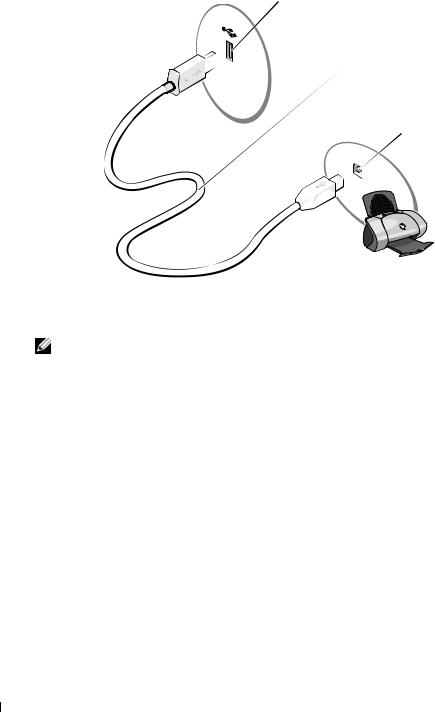
 USB connector on computer
USB connector on computer
 USB printer cable
USB printer cable
 USB connector on printer
USB connector on printer
Connecting to the Internet
NOTE: ISPs and ISP offerings vary by country.
To connect to the Internet, you need a modem or network connection and an Internet service provider (ISP), such as AOL or MSN. Your ISP will offer one or more of the following Internet connection options:
•Dial-up connections that provide Internet access through a telephone line. Dial-up connections are considerably slower than DSL and cable modem connections.
•DSL connections that provide high-speed Internet access through your existing telephone line. With a DSL connection, you can access the Internet and use your telephone on the same line simultaneously.
•Cable modem connections that provide high-speed Internet access through your local cable TV line.
If you are using a dial-up connection, connect a telephone line to the modem connector on your computer and to the telephone wall jack before you set up your Internet connection. If you are using a DSL or cable modem connection, contact your ISP for setup instructions.
14 Setting Up and Using Your Computer

Setting Up Your Internet Connection
To set up an AOL or MSN connection:
1Save and close any open files, and exit any open programs.
2Double-click the MSN Explorer or AOL icon on the Microsoft® Windows® desktop.
3Follow the instructions on the screen to complete the setup.
If you do not have an MSN Explorer or AOL icon on your desktop or if you want to set up an Internet connection with a different ISP:
1Save and close any open files, and exit any open programs.
2Click the Start button and click Internet Explorer. The New Connection Wizard appears.
3Click Connect to the Internet.
4In the next window, click the appropriate option:
•If you do not have an ISP and want to select one, click Choose from a list of Internet service providers (ISPs).
•If you have already obtained setup information from your ISP but you did not receive a setup CD, click Set up my connection manually.
•If you have a CD, click Use the CD I got from an ISP.
5Click Next.
If you selected Set up my connection manually, continue to step 6. Otherwise, follow the instructions on the screen to complete the setup.
NOTE: If you do not know which type of connection to select, contact your ISP.
6Click the appropriate option under How do you want to connect to the Internet?, and then click Next.
7Use the setup information provided by your ISP to complete the setup.
If you are having problems connecting to the Internet, see "E-Mail, Modem, and Internet Problems" on page 33. If you cannot connect to the Internet but have successfully connected in the past, the ISP might have a service outage. Contact your ISP to check the service status, or try connecting again later.
Setting Up and Using Your Computer |
|
15 |
|
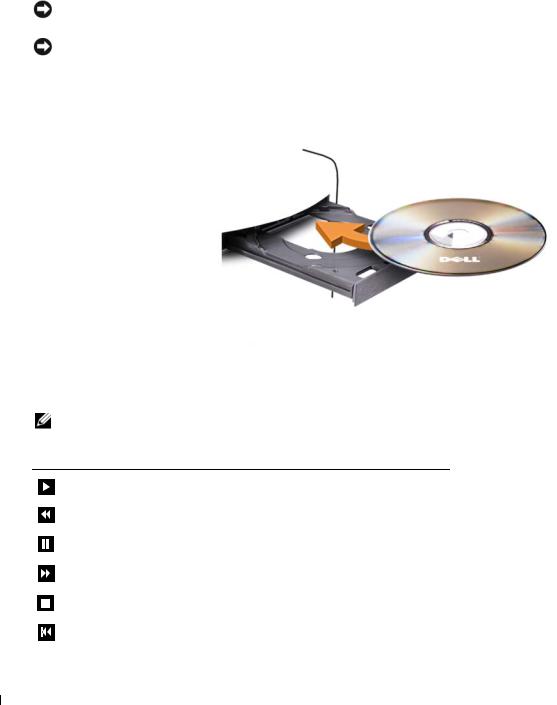
Playing CDs and DVDs
NOTICE: Do not press down on the CD or DVD tray when you open or close it. Keep the tray closed when you are not using the drive.
NOTICE: Do not move the computer when you are playing CDs or DVDs.
1Press the eject button on the front of the drive.
2Place the disc, label side up, in the center of the tray.
3 Press the eject button or gently push in the tray.
To format CDs for storing data, to create music CDs, or to copy CDs, see the CD software that came with your computer.
NOTE: Ensure that you follow all copyright laws when you create CDs.
A CD player includes the following basic buttons:
Play
Move backward within the current track
Pause
Move forward within the current track
Stop
Go to the previous track
16 Setting Up and Using Your Computer

Eject
Go to the next track
A DVD player includes the following basic buttons:
Stop
Restart the current chapter
Play
Fast forward
Pause
Fast reverse
Advance a single frame while in pause mode
Go to the next title or chapter
Continuously play the current title or chapter
Go to the previous title or chapter
Eject
For more information on playing CDs or DVDs, click Help on the CD or DVD player (if available).
Adjusting the Volume
NOTE: When the speakers are muted, you do not hear the CD or DVD playing.
1Click the Start button, point to All Programs → Accessories→ Entertainment, and then click Volume Control.
2In the Volume Control window, click and drag the bar in the Volume Control column and slide it up or down to increase or decrease the volume.
For more information on volume control options, click Help in the Volume Control window.
Setting Up and Using Your Computer |
|
17 |
|

Adjusting the Picture
If an error message notifies you that the current resolution and color depth are using too much memory and preventing DVD playback, adjust the display properties:
1Click the Start button and click Control Panel.
2Under Pick a category, click Appearance and Themes.
3Under Pick a task..., click Change the screen resolution.
4In the Display Properties window, click and drag the bar in Screen resolution to change the setting to 800 by 600 pixels.
5Click the drop-down menu under Color quality, and then click Medium (16 bit).
6Click OK.
Copying CDs and DVDs
NOTE: Ensure that you observe all copyright laws when creating CDs or DVDs.
This section applies only to computers that have a CD-RW, DVD+/-RW, or CD-RW/DVD (combo) drive.
NOTE: The types of CD or DVD drives offered by Dell may vary by country.
The following instructions explain how to make an exact copy of a CD or DVD. You can also use Sonic DigitalMedia for other purposes, such as creating music CDs from audio files stored on your computer or backing up important data. For help, open Sonic DigitalMedia and then click the question mark icon in the upper-right corner of the window.
How to Copy a CD or DVD
NOTE: CD-RW/DVD combo drives cannot write to DVD media. If you have a CD-RW/DVD combo drive and you experience recording problems, check for available software patches on the Sonic support website at www.sonic.com.
The DVD-writable drives installed in Dell™ computers can write to and read DVD+/-R, DVD+/-RW and DVD+R DL (dual layer) media, but cannot write to and may not read DVD-RAM or DVD-R DL media.
NOTE: Most commercial DVDs have copyright protection and cannot be copied using Sonic DigitalMedia.
1Click the Start button, point to All Programs→ Sonic→ DigitalMedia Projects, and then click Copy.
2Under the Copy tab, click Disc Copy.
18 Setting Up and Using Your Computer

3To copy the CD or DVD:
•If you have one CD or DVD drive, ensure that the settings are correct and click the Disc Copy button. The computer reads your source CD or DVD and copies the data to a temporary folder on your computer hard drive.
When prompted, insert a blank CD or DVD into the drive and click OK.
•If you have two CD or DVD drives, select the drive into which you have inserted your source CD or DVD and click the Disc Copy button. The computer copies the data from the source CD or DVD to the blank CD or DVD.
Once you have finished copying the source CD or DVD, the CD or DVD that you have created automatically ejects.
Using Blank CDs and DVDs
CD-RW drives can write to CD recording media only (including high-speed CD-RW) while DVD-writable drives can write to both CD and DVD recording media.
Use blank CD-Rs to record music or permanently store data files. After creating a CD-R, you cannot write to that CD-R again (see the Sonic documentation for more information). Use blank CD-RWs to write to CDs or to erase, rewrite, or update data on CDs.
Blank DVD+/-Rs can be used to permanently store large amounts of information. After you create a DVD+/-R disc, you may not be able to write to that disc again if the disc is "finalized" or "closed" during the final stage of the disc creation process. Use blank DVD+/-RWs if you plan to erase, rewrite, or update information on that disc later.
CD-Writable Drives
Media Type |
Read |
Write |
Rewritable |
|
|
|
|
CD-R |
Yes |
Yes |
No |
CD-RW |
Yes |
Yes |
Yes |
|
|
|
|
DVD-Writable Drives |
|
|
|
|
|
|
|
Media Type |
Read |
Write |
Rewritable |
|
|
|
|
CD-R |
Yes |
Yes |
No |
CD-RW |
Yes |
Yes |
Yes |
DVD+R |
Yes |
Yes |
No |
DVD-R |
Yes |
Yes |
No |
DVD+RW |
Yes |
Yes |
Yes |
DVD-RW |
Yes |
Yes |
Yes |
DVD+R DL |
Yes |
Yes |
No |
Setting Up and Using Your Computer |
|
19 |
|

Media Type |
Read |
Write |
Rewritable |
|
|
|
|
DVD-R DL |
Maybe |
No |
No |
DVD-RAM |
Maybe |
No |
No |
|
|
|
|
Helpful Tips
•Use Microsoft® Windows® Explorer to drag and drop files to a CD-R or CD-RW only after you start Sonic DigitalMedia and open a DigitalMedia project.
•Use CD-Rs to burn music CDs that you want to play in regular stereos. CD-RWs do not play in most home or car stereos.
•You cannot create audio DVDs with Sonic DigitalMedia.
•Music MP3 files can be played only on MP3 players or on computers that have MP3 software installed.
•Commercially available DVD players used in home theater systems may not support all available DVD formats. For a list of formats supported by your DVD player, see the documentation provided with your DVD player or contact the manufacturer.
•Do not burn a blank CD-R or CD-RW to its maximum capacity; for example, do not copy a 650-MB file to a blank 650-MB CD. The CD-RW drive needs 1–2 MB of the blank space to finalize the recording.
•Use a blank CD-RW to practice CD recording until you are familiar with CD recording techniques. If you make a mistake, you can erase the data on the CD-RW and try again. You can also use blank CD-RWs to test music file projects before you record the project permanently to a blank CD-R.
•See the Sonic website at www.sonic.com for additional information.
Using a Media Card Reader (Optional)
Use the Media Card Reader to transfer data directly to your computer.
The Media Card Reader supports the following memory types:
•xD-Picture Card
•SmartMedia (SMC)
•CompactFlash Type I and II (CF I/II)
•MicroDrive Card
•SecureDigital Card (SD)
•MultiMediaCard (MMC)
•Memory Stick (MS/MS Pro)
20 Setting Up and Using Your Computer
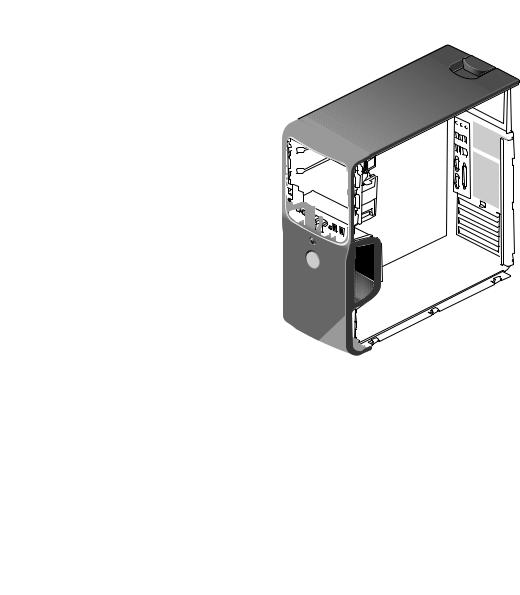
For information on installing a Media Card Reader, see "Installing a Media Card Reader" on page 89.
 Memory Stick
Memory Stick
(MS/MS Pro)
xD-Picture Card and |
SmartMedia (SMC) |
CompactFlash Type I |
and II (CF I/II) and |
MicroDrive Card |
SecureDigital Card (SD)/
MultiMediaCard (MMC)
To use the Media Card Reader:
1Check the media or card to determine the proper orientation for insertion.
2Slide the media or card into the appropriate slot until it is completely seated in the connector.
If you encounter resistance, do not force the media or card. Check the card orientation and try again.
Setting Up a Home and Office Network
Connecting to a Network Adapter
NOTICE: Plug the network cable into the network adapter connector on the computer. Do not plug the network cable into the modem connector on the computer.
NOTICE: Do not plug a network cable into a telephone wall jack.
1Connect the network cable to the network adapter connector on the back of your computer. Insert the cable until it clicks into place, and then gently pull it to ensure that it is secure.
Setting Up and Using Your Computer |
|
21 |
|
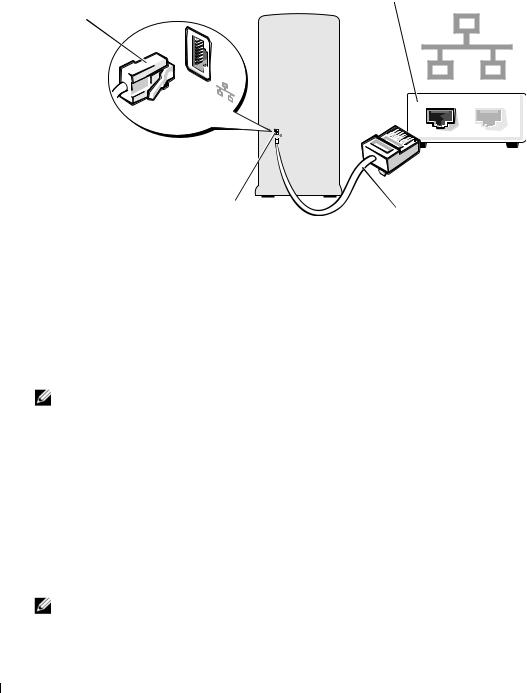
2 Connect the other end of the network cable to a network device.
network adapter |
network device |
connector |
|
network adapter connector on computer
 network cable
network cable
Network Setup Wizard
The Microsoft® Windows® XP operating system provides a Network Setup Wizard to guide you through the process of sharing files, printers, or an Internet connection between computers in a home or small office.
1Click the Start button, point to All Programs→ Accessories→ Communications, and then click Network Setup Wizard.
2On the welcome screen, click Next.
3Click Checklist for creating a network.
NOTE: Selecting the connection method This computer connects directly to the Internet enables the integrated firewall provided with Windows XP.
4Complete the checklist and required preparations.
5Return to the Network Setup Wizard and follow the instructions on the screen.
Power Management
The Microsoft® Windows® XP power management features can reduce the amount of electricity your computer uses when it is on and you are not using it. You can reduce power to just the monitor or the hard drive, or you can use standby mode or hibernate mode to reduce power to the entire computer. When the computer exits from a power conservation mode, the Windows desktop is restored to the state it was in before it entered the mode.
NOTE: Windows XP Professional includes security and networking features not available in Windows XP Home Edition. When a Windows XP Professional computer is connected to a network, different options related to security and networking appear in certain windows.
22 Setting Up and Using Your Computer

Standby Mode
Standby mode conserves power by turning off the display and the hard drive after a time-out. When the computer exits from standby mode, it returns to the operating state it was in before it entered standby mode.
To set standby mode to automatically activate after a defined period of inactivity:
1Click the Start button and click Control Panel.
2Under Pick a category, click Performance and Maintenance.
3Under or pick a Control Panel icon, click Power Options.
To immediately activate standby mode without a period of inactivity, click the Start button, click
Turn Off Computer, and then click Stand by.
To exit from standby mode, press a key on the keyboard or move the mouse.
NOTICE: If your computer loses power while in standby mode, it may lose data.
Hibernate Mode
Hibernate mode conserves power by copying system data to a reserved area on the hard drive and then completely turning off the computer. When the computer exits from hibernate mode, the desktop is restored to the state it was in before it entered hibernate mode.
To activate hibernate mode:
1Click the Start button and click Control Panel.
2Under Pick a category, click Performance and Maintenance.
3Under or pick a Control Panel icon, click Power Options.
4Define your hibernate settings on the Power Schemes tab, Advanced tab, and Hibernate tab.
To exit from hibernate mode, press the power button. The computer may take a short time to exit from hibernate mode. Pressing a key on the keyboard or moving the mouse does not bring the computer out of hibernation, because the keyboard and the mouse do not function when the computer is in hibernate mode.
Because hibernate mode requires a special file on your hard drive with enough disk space to store the contents of the computer memory, Dell creates an appropriately sized hibernate mode file before shipping the computer to you. If the computer’s hard drive becomes corrupted, Windows XP recreates the hibernate file automatically.
Power Options Properties
Define your standby mode settings, hibernate mode settings, and other power settings in the Power Options Properties window. To access the Power Options Properties window:
1Click the Start button and click Control Panel.
2Under Pick a category, click Performance and Maintenance.
Setting Up and Using Your Computer |
|
23 |
|

3Under or pick a Control Panel icon, click Power Options.
4Define your power settings on the Power Schemes tab, Advanced tab, and Hibernate tab.
Power Schemes Tab
Each standard power setting is called a scheme. If you want to select one of the standard Windows schemes installed on your computer, choose a scheme from the Power schemes drop-down menu. The settings for each scheme appear in the fields below the scheme name. Each scheme has different settings for starting standby mode or hibernate mode, turning off the monitor, and turning off the hard drive.
The Power schemes drop-down menu displays the following schemes:
•Always On (default) — If you want to use your computer with no power conservation.
•Home/Office Desk — If you use your computer as a home or office computer and you require minimal power conservation.
•Presentation — If you want your computer to run without interruption (using no power conservation).
•Minimal Power Management — If you want your computer to run with minimal power conservation.
•Max Battery — If your computer is a portable computer and you run your computer from batteries for extended periods of time.
If you want to change the default settings for a scheme, click the drop-down menu in the Turn off monitor, Turn off hard disks, System stand by, or System hibernates field, and then select a timeout from the displayed list. Changing the time-out for a scheme field permanently changes the default settings for that scheme, unless you click Save As and enter a new name for the changed scheme.
NOTICE: If you set the hard drive (hard disk) to time-out before the monitor does, your computer may appear to be locked up. To recover, press any key on the keyboard or click the mouse. To avoid this problem, always set the monitor to time-out before the hard drive.
Advanced Tab
The Advanced tab allows you to:
•Place the power options icon in the Windows taskbar for quick access.
•Set the computer to prompt you for your Windows password before the computer exits from standby mode or hibernate mode.
•Program the power button to activate standby mode, activate hibernate mode, or turn off the computer.
To program these functions, select an option from the corresponding drop-down menu and click OK.
24 Setting Up and Using Your Computer

Hibernate Tab
The Hibernate tab allows you to enable hibernate mode. If you want to use the hibernate settings you defined on the Power Schemes tab, click the Enable hibernate support check box on the
Hibernate tab.
For more information on power management options:
1Click the Start button and click Help and Support.
2In the Help and Support window, click Performance and maintenance.
3In the Performance and maintenance window, click Conserving power on your computer.
About RAID Configurations
This section provides an overview of the RAID configuration that you might have selected when you purchased your computer. Of the several RAID configurations available in the computer industry for different types of uses, Dell offers RAID level 1 on your computer. This configuration is recommended for users that desire a higher level of data integrity.
The Intel RAID controller on your computer can only create a RAID configuration using two physical drives. The drives should be the same size to ensure that the larger drive does not contain unallocated (and therefore unusable) space.
NOTE: RAID levels do not represent a hierarchy. A RAID level 1 configuration is not inherently better or worse than a RAID level 0 configuration.
Using RAID with Hard Drive Passwords
If you are using a hard-drive security option available in system setup (see page 104), you should not use a RAID configuration. Using a RAID configuration requires that the hard drive password be cleared to allow data access.
RAID Level 1
RAID level 1 uses a data-redundancy storage technique known as "mirroring." When data is written to the primary drive, the data is then duplicated—or mirrored—on the other drive. A RAID level 1 configuration sacrifices high-data access rates for its data redundancy advantages.
Setting Up and Using Your Computer |
|
25 |
|

serial ATA RAID configured for RAID level 1
segment 1
segment 2
segment 3
segment 4
segment 5
segment 6
segment 1 duplicated
segment 2 duplicated
segment 3 duplicated
segment 4 duplicated
segment 5 duplicated
segment 6 duplicated
hard drive 1 |
hard drive 2 |
If a drive failure occurs, subsequent read and write operations are directed to the surviving drive. A replacement drive can then be rebuilt using the data from the surviving drive. Also, because data is duplicated on both drives, two 120-GB RAID level 1 drives collectively have a maximum of 120-GB on which to store data.
Configuring Your Computer for RAID
You may want to configure your computer for RAID at some point, if you did not select a RAID configuration when you purchased your computer. You must have at least two hard drives installed in your computer to set up a RAID configuration. For instructions on how to install a hard drive, see "Hard Drive" on page 79.
You can use one of two methods to configure RAID hard drive volumes. One method uses the Intel RAID Option ROM utility and is performed before you install the operating system onto the hard drive. The second method uses the Intel Matrix Storage Manager, or Intel Matrix Storage Console, and this method is performed after you have installed the operating system and the Intel Matrix Storage Console. Both methods require that you set your computer to RAID-enabled mode before starting any of the RAID configuration procedures in this document.
Setting Your Computer to RAID-Enabled Mode
1Enter system setup (see page 103).
2Press the upand down-arrow keys to highlight Drives, and press <Enter>.
3Press the upand down-arrow keys to highlight SATA Operation, and press <Enter>.
26 Setting Up and Using Your Computer

4Press the leftand right-arrow keys to highlight RAID On, press <Enter>, and then press <Esc>.
NOTE: For more information about RAID options, see "System Setup Options" on page 104.
5Press the leftand right-arrow keys to highlight Save/Exit, and press <Enter> to exit system setup and resume the boot process.
Configuring Your Computer for RAID Using the Intel® RAID Option ROM Utility
NOTE: Although any size drives may be used to create a RAID configuration when using the Intel RAID Option ROM utility, ideally the drives should be of equal size. In a RAID level 1 configuration, the size of the configuration will be the smaller of the two drives used.
Creating a RAID Level 1 Configuration
1Set your computer to RAID-enabled mode (see page 26).
2Press <Ctrl><i> when you are prompted to enter the Intel RAID Option ROM utility.
3Use the upand down-arrow keys to highlight Create RAID Volume and press <Enter>.
4Enter a RAID volume name or accept the default and press <Enter>.
5Use the upand down-arrow keys to select RAID1(Mirror) and press <Enter>.
6If there are more than two hard drives available, press the upand down-arrow keys and spacebar to select the two drives you want to use to make up your volume, and then press <Enter>.
7Select the desired capacity for the volume, and press <Enter>. The default value is the maximum available size.
8Press <Enter> to create the volume.
9Press <y> to confirm that you want to create the RAID volume.
10Confirm that the correct volume configuration is displayed on the main Intel RAID Option ROM utility screen.
11Use the upand down-arrow keys to select Exit and press <Enter>.
12Install the operating system (see "Using Microsoft® Windows® XP System Restore" on page 55).
Deleting a RAID Volume
NOTE: When you perform this operation, all data on the RAID drives will be lost.
NOTE: If your computer currently boots to RAID and you delete the RAID volume in the Intel RAID Option ROM utility, your computer will become unbootable.
1Press <Ctrl><i> when you are prompted to enter the Intel RAID Option ROM utility.
2Use the upand down-arrow keys to highlight Delete RAID Volume, and press <Enter>.
Setting Up and Using Your Computer |
|
27 |
|

3Use the upand down-arrow keys to highlight the RAID volume you want to delete, and press <Delete>.
4Press <y> to confirm the deletion of the RAID volume.
5Press <Esc> to exit the Intel RAID Option ROM utility.
Configuring Your Computer for RAID Using the Intel Matrix Storage Manager
If you already have one hard drive with the operating system installed on it, and you want to add a second hard drive and reconfigure both drives into a RAID volume without losing the existing operating system and any data, you need to use the migrating option for a RAID level 1 configuration (see page 29).
Create a RAID level 1 volume only when you already have a two-hard drive computer configured into a volume, but you still have some space left on the volume that you want to designate as a second RAID volume.
Creating a RAID Level 1 Configuration
NOTE: When you perform this operation, all data on the RAID drives will be lost.
1Set your computer to RAID-enabled mode (see page 26).
2Click the Start button and point to Programs→ Intel(R) Matrix Storage Manager→ Intel Matrix Storage Console to launch the Intel® Storage Utility.
NOTE: If you do not see an Actions menu option, you have not yet set your computer to RAID-enabled mode (see page 26).
3On the Actions menu, select Create RAID Volume to launch the Create RAID Volume Wizard.
4Click Next at the first screen.
5Confirm the volume name, select RAID 1 as the RAID level, and then click Next to continue.
6On the Select Volume Location screen, click the first hard drive you want to use to create your RAID level 1 volume, and then click the right arrow. Click a second hard drive until two drives appear in the Selected window, and then click Next.
7In the Specify Volume Size window, select the Volume Size desired and click Next.
8Click Finish to create the volume, or click Back to make changes.
9Follow Microsoft Windows procedures for creating a partition on the new RAID volume.
Deleting a RAID Volume
NOTE: While this procedure deletes the RAID 1 volume, it also splits the RAID 1 volume into two nonRAID hard drives with a partition, and leaves any existing data files intact.
1Click the Start button and point to Programs→ Intel(R) Matrix Storage Manager→ Intel Matrix Storage Console to launch the Intel Storage Utility.
28 Setting Up and Using Your Computer

2Right-click the Volume icon of the RAID volume you want to delete, and select Delete Volume.
3On the Delete RAID Volume Wizard screen, click Next.
4Highlight the RAID volume you want to delete in the Available box, click the right-arrow button to move the highlighted RAID volume into the Selected box, and then click Next.
5Click Finish to delete the volume.
Migrating to a RAID Level 1 Configuration
1Set your computer to RAID-enabled mode (see page 26).
2Click the Start button and point to All Programs→ Intel(R) Matrix Storage Manager→ Intel Matrix Storage Console to launch the Intel Storage Utility.
NOTE: If you do not see an Actions menu option, you have not yet set your computer to RAID-enabled mode (see page 26).
3On the Actions menu, click Create RAID Volume From Existing Hard Drive to launch the Migration Wizard.
4Click Next on the first Migration Wizard screen.
5Enter a RAID volume name or accept the default.
6From the drop-down box, select RAID 1 as the RAID level.
NOTE: Select the hard drive that you want to use as your source hard drive (it should be the hard drive containing the data or operating system files that you want to keep on the RAID volume).
7On the Select Source Hard Drive screen, double-click the hard drive from which you want to migrate, and click Next.
8On the Select Member Hard Drive screen, double-click the hard drive to select the member drive that you want to act as the mirror in the configuration, and click Next.
9On the Specify Volume Size screen, select the volume size you want, and click Next.
NOTE: In step 10, all data contained on the member drive will be removed.
10Click Finish to start migrating, or click Back to make changes. You can use your computer normally during migration process.
Rebuilding a Degraded RAID Level 1 Configuration
If your computer has reported a degraded RAID level 1 volume, you can manually rebuild the computer’s redundancy mirror to a new hard drive:
1Click the Start button and point to Programs→ Intel(R) Matrix Storage Manager→ Intel Matrix Storage Console to launch the Intel Storage Utility.
2Right-click the available hard drive to which you want to rebuild the RAID level 1 volume, and click Rebuild to this Disk.
3You can use your computer while the computer is rebuilding the RAID level 1 volume.
Setting Up and Using Your Computer |
|
29 |
|

Hyper-Threading
NOTE: Not all processors support hyper-threading technology.
Hyper-Threading is an Intel® technology that can enhance overall computer performance by allowing one physical processor to function as two logical processors, capable of performing certain tasks simultaneously. It is recommended that you use the Microsoft® Windows® XP Service Pack 1 (SP1) or later operating system because Windows XP is optimized to take advantage of Hyper-Threading technology. While many programs can benefit from Hyper-Threading, some programs have not been optimized for Hyper-Threading and may require an update from the software manufacturer. Contact the software manufacturer for updates and information about using Hyper-Threading with your software.
To determine if your computer is using Hyper-Threading technology:
1Click the Start button, right-click My Computer, and then click Properties.
2Click Hardware and click Device Manager.
3In the Device Manager window, click the plus (+) sign next to Processors. If Hyper-Threading is enabled, the processor is listed twice.
You can enable or disable Hyper-Threading through system setup. For more information on accessing system setup, see page 103. For more information on Hyper-Threading, search the Knowledge Base on the Dell Support website at support.dell.com.
30 Setting Up and Using Your Computer
